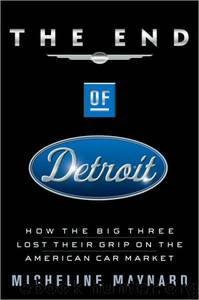End of Detroit by Micheline Maynard

Author:Micheline Maynard [Maynard, Micheline]
Language: eng
Format: epub
Tags: United States, Economics, Business & Economics, Industries, Corporate & Business History, Transportation, Automobile Industry, Forecasting, Automobile Industry and Trade, Automobile Industry and Trade - United States - Forecasting, Competition; International, Antique & Classic, Automotive, International, Automobile Industry and Trade - United States
ISBN: 9780385511520
Publisher: Broadway Business
Published: 2003-09-23T00:00:00+00:00
CHAPTER SEVEN
NIBBLING FROM THE BOTTOM AND THE TOP
BMW AND HYUNDAI start at completely opposite ends of the automotive spectrum. One is a venerable maker of German luxury cars that holds an unmatched position in the car market for its breathtakingly fast performance automobiles. The other is an upstart from Korea, earning its reputation for selling bargain cars, accompanied by a generous warranty. But BMW and Hyundai have one very important trait in common. They each want more. BMW, at the top of the automotive market, and Hyundai, at the bottom, are both gunning to expand their presence in the United States during this decade, fueled by vehicles they build, or plan to build, at plants in the United States. As a starting point, they share a confidence that Detroit’s auto companies have never been able to achieve. They know exactly who they are. BMW and Hyundai have carefully defined brand images, a clear understanding of why people buy their cars, and strong-willed executives who tune out the criticism and complaints of competing companies to focus on their goals. Both dominate markets where Detroit cannot figure out how to successfully compete, despite numerous attempts and failures. BMW and Hyundai each knows its expansion plans are a gamble, but each knows that it must gamble in order to grow. Importantly, each company knows what it is like to falter, for both companies soared in the late 1980s, only to fall ignominiously during the 1990s. They have both gotten back on their feet, and like Carlos Ghosn at Nissan, they do not plan to stumble again.
BMW and Hyundai, along with other import companies, represent a force that has weakened Detroit during the past decade. With the exception of Toyota and its expansive lineup, none of the import companies has designs on meeting Detroit head-on in every segment where it competes. They don’t have to. They can be successful by fixing their targets and taking away markets, one by one. They are doing this by introducing more models, of all types, while Detroit shifts from one extreme to the other, unable to balance its approach in order to meet the competition coming at it from all corners.
Look at what happened to the U.S. car market in the five model years between 1998 and 2002. In 1998, the Detroit companies clearly had more for customers to choose from. According to Edmunds.com, they sold 75 different car nameplates, of all sizes and varieties, from entry level to luxury. They sold 52 different light truck nameplates, including minivans, SUVs and pickup trucks. Import companies lagged far behind. In 1998, they sold 63 different car nameplates and just 27 truck nameplates. In those years, GM, Ford and Chrysler were simultaneously swept by the notion that Americans wanted more light trucks. They rushed to build them, giving short shrift, in the process, to their car lineups. Detroit companies’ single-mindedness was like an airplane tipping to one side as all the passengers shift across the aisle to peer out the windows at the sights below.
Download
This site does not store any files on its server. We only index and link to content provided by other sites. Please contact the content providers to delete copyright contents if any and email us, we'll remove relevant links or contents immediately.
| Biographies | Company Profiles |
| Economic History |
Pale Blue Dot by Carl Sagan(4944)
The Rules Do Not Apply by Ariel Levy(4904)
Goodbye Paradise(3757)
Ogilvy on Advertising by David Ogilvy(3546)
Liar's Poker by Michael Lewis(3406)
Delivering Happiness by Tony Hsieh(3391)
Into Thin Air by Jon Krakauer(3340)
Purple Cow by Seth Godin(3159)
Rogue Trader by Leeson Nick(3004)
The Social Psychology of Inequality by Unknown(2984)
The Airbnb Story by Leigh Gallagher(2817)
4 - Harry Potter and the Goblet of Fire by J.K. Rowling(2678)
The Mind Map Book by Tony Buzan(2545)
Bossypants by Tina Fey(2495)
Claridge's: The Cookbook by Nail Martyn & Erickson Meredith(2375)
All the President's Men by Carl Bernstein & Bob Woodward(2341)
Six Billion Shoppers by Porter Erisman(2277)
Master of the Game by Sidney Sheldon(2259)
Alibaba by Duncan Clark(2054)
